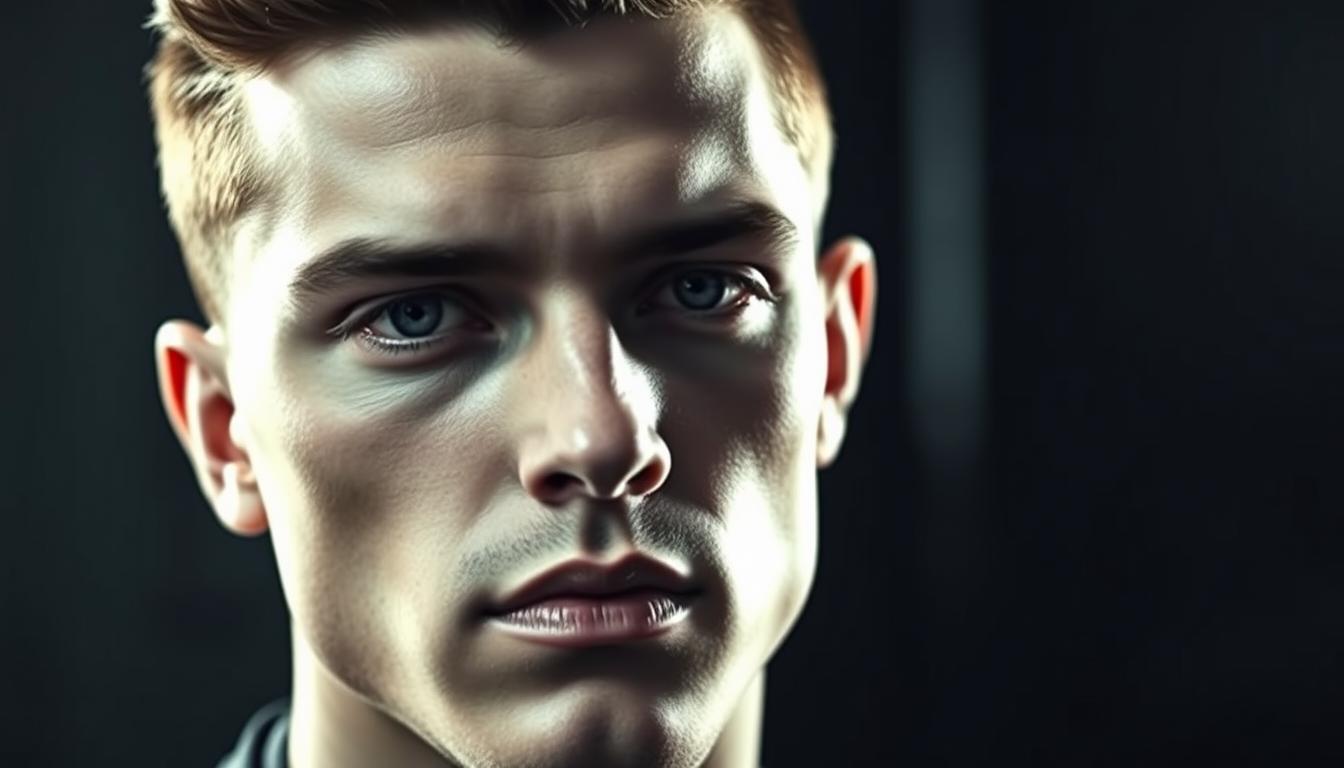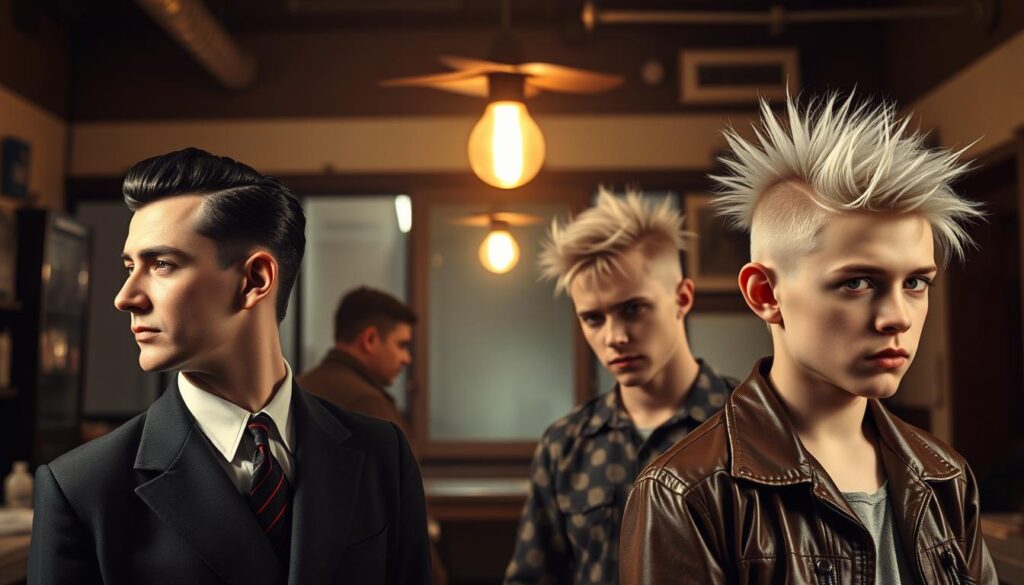
What if a simple hairstyle could shape history’s darkest moments and still dominate modern fashion? The undercut—a style defined by its stark contrast between long top hair and shaved sides—carries a legacy far beyond barber chairs. Though widely popular today, its roots stretch back to early 20th-century Europe, where it became unintentionally tied to political symbolism.
Originally trendy among men in the 1910s, this cut saw military adoption decades later. Soldiers favored its practicality, but its association with certain historical groups created lasting controversy. Despite this, the style resurged in the 1980s and again in the 2010s, proving its timeless appeal.
You’ll notice modern versions keep the sharp side parting and textured top, blending vintage elements with contemporary flair. Barbers often recommend it for its versatility—suited for both formal events and casual looks. Yet choosing this hairstyle means acknowledging its complex past while embracing its present-day reinvention.
Key Takeaways
- The undercut hairstyle dates back to early 20th-century Europe
- Military adoption influenced its controversial associations
- Modern versions prioritize texture and contrast
- Versatility makes it popular across generations
- Historical context shapes its cultural significance today
Historical Origins and Cultural Significance

From gritty streets to global runways, some styles carry hidden histories. The undercut began as a practical choice among early 1900s working-class youth. Street fighters in cities like Birmingham and Manchester favored shorter sides to prevent opponents from grabbing their hair during brawls.
By the 1920s, jazz clubs and dance halls transformed this utilitarian look into a fashion statement. Wealthier crowds adopted the style, pairing it with tailored suits and slicked-back tops. This shift showed how trends could cross social divides when cultural movements embraced them.
Evolution of the Style Over the Decades
World War II marked a turning point. Military forces standardized the cut for its low maintenance, unintentionally linking it to political uniforms. Groups like the Hitler Youth adopted it as part of their image, creating lasting stigma.
Impact of Nazi Germany and Post-War Adoption
Post-war Europe faced a dilemma—how to reclaim a style tainted by recent history. Fashion magazines in the 1950s rebranded the look as “preppy,” focusing on clean lines rather than dark associations. You’ll notice how designers emphasized versatility, making it suitable for both rebellious teens and polished professionals.
The Distinct Features of the Classic Style

Some hairstyles demand attention through precision rather than flair. The classic version stands out with razor-sharp lines and meticulous grooming. Every element serves a purpose, from the defined side parting to the polished finish that catches light like liquid.
Key Elements and Signature Details
You’ll recognize this look by its surgical-grade symmetry. The side parting slices through the head like a ruler, separating longer crown hair from shaved temples. Unlike modern styles, the classic version requires hair to lie perfectly flat—no tousled texture allowed.
Barbers achieve this through gradual tapering from the top to ultra-short sides. The back stays equally cropped, often featuring geometric designs for added edge. Traditional bangs disappear completely, directing focus to the forehead and jawline.
Differences Between This Look and the Modern Undercut
Today’s versions prioritize flexibility over formality. While both styles use contrasting lengths, modern cuts embrace messy tops and softer transitions. You can spot the divergence in three key areas:
| Feature | Classic Style | Modern Undercut |
|---|---|---|
| Side Parting | Razor-sharp, non-negotiable | Optional or blurred |
| Top Length | Uniform, slicked back | Layered, textured |
| Styling Products | Heavy gel/wax required | Matte paste preferred |
| Sides/Back | Skin-tight with patterns | Faded or natural |
The classic approach leaves no room for error. Your hair must stay disciplined—think military inspection-ready. Contemporary versions let you wake up and go, celebrating imperfection as part of the charm.
Mastering the Hitler Haircut
Precision defines this iconic look. Achieving its sharp lines requires technical skill, whether you’re in a barber’s chair or tackling it at home. Modern tools have transformed the process, but the core principles remain unchanged since the 1950s.
Step-by-Step Cutting Process
Start by dividing the head into four zones: crown, back, and both temples. Use a fine-toothed comb to create clean partings. Professional barbers select a control curl at the crown—this determines your top length and guides all other sections.
Trim the sides first with clippers set to a #1 or #2 guard. Move upward gradually, blending lengths for seamless transitions. Leave the crown area 2-3 inches longer. Thinning scissors add texture here, preventing a bulky appearance.
Essential Tools and Techniques
Your toolkit makes or breaks the result. Quality clippers with multiple guards handle bulk removal, while precision scissors refine edges. A razor-edged comb creates surgical-grade partings, and matte paste locks everything in place.
| Tool | Purpose | Modern Upgrade |
|---|---|---|
| Clippers | Bulk removal | Adjustable guards (0.5mm-10mm) |
| Thinning Shears | Texture creation | 40-tooth blades |
| Styling Paste | Shape retention | 24-hour humidity resistance |
Finish with a dime-sized amount of strong-hold product. Work it through damp hair, combing upward for maximum volume. This method maintains structure without stiffness—crucial for all-day wear.
Daily Care and Maintenance Tips
Maintaining sharp lines requires more than occasional trims. Your daily routine determines whether your style stays crisp or collapses before lunch. Start by setting aside 10 minutes each morning—beginners might need 30 until muscle memory kicks in.
Establishing a Consistent Styling Routine
Blow-dry damp hair upward at the roots first. This creates natural volume while preparing strands for product application. Winter demands adjustments—leave slightly more length on top and sides to combat hat-induced flattening.
Schedule barber visits every 6-8 weeks. Professionals reshape fading edges and rebalance proportions. They’ll show you home styling tricks using common tools like fine-tooth combs or rounded brushes.
Top Product Recommendations for Strong Hold
Cheap gels create helmet-head shine without staying power. Invest in professional-grade products:
- Matte wax for flexible texture
- High-hold paste with humidity resistance
- Sea salt spray for added grip
Wavy-haired users benefit from flat irons or discreet bobby pins. Always apply products to towel-dried hair—this helps distribute them evenly. Reapplying mid-day leads to buildup, so choose formulas that last 12+ hours.
Your appearance maintenance reflects commitment to the style’s heritage. Proper care transforms a simple haircut into a signature look that withstands weather, activity, and time.
Styling Options and Celebrity Inspirations
A hairstyle’s true power lies in its ability to transform identities while complementing natural features. This iconic look adapts effortlessly across face shapes, offering tailored enhancements that boost confidence and refine personal image.
Versatile Looks for Various Face Shapes
Your face shape determines how to maximize this style’s impact. Triangular faces gain smoothness with slightly longer top layers, while round faces appear more symmetrical when sides stay ultra-cropped.
Square jawlines benefit from sharp side partings that emphasize bone structure. Oval faces become canvases for creativity—experiment with textured tops or one-side dominance to highlight your best angles.
| Face Shape | Styling Strategy | Celebrity Example |
|---|---|---|
| Round | High-contrast sides | Joe Jonas |
| Square | Angular side part | Marco Reus |
| Oval | Textured volume | Zachary Quinto |
| Triangular | Softened edges | David Beckham |
Modern Trends and Celebrity Examples
New York fashion weeks recently showcased updated versions with disconnected fades and asymmetric designs. Football stars like Ilkay Gundogan pair the style with understated beards, creating rugged yet polished looks.
Reality TV icons in the UK popularized glossy finishes for camera-ready appeal. Meanwhile, actors often add subtle highlights or tousled textures to stand out on red carpets without losing the cut’s geometric foundation.
Conclusion
How does a hairstyle survive decades of controversy to become a modern staple? This journey through its technical precision and cultural layers shows how timeless design outlives turbulent origins. You’ve seen how barbers blend historical techniques with today’s trends, creating looks that respect the past while fitting current aesthetics.
Your toolkit now includes cutting methods, product choices, and face-shape strategies. Celebrity adaptations prove the style’s flexibility—whether paired with bold beards or sleek textures. Maintenance routines and professional trims keep the sharp contrast between top and sides intact, ensuring polished results.
Adopting this look means balancing personal expression with awareness of its complex heritage. Work with skilled stylists to achieve clean lines that match your individual appearance. Ultimately, it’s about choosing a hairstyle that carries weight in history yet adapts effortlessly to modern life.
